 Rob has put a great collection of vintage and contemporary concrete garden dogs together.
Rob has put a great collection of vintage and contemporary concrete garden dogs together.
This live wire is all mine.
Deborah Silver is an accomplished and experienced landscape and garden designer whose firm first opened its doors in 1986.
 Rob has put a great collection of vintage and contemporary concrete garden dogs together.
Rob has put a great collection of vintage and contemporary concrete garden dogs together.
This live wire is all mine.
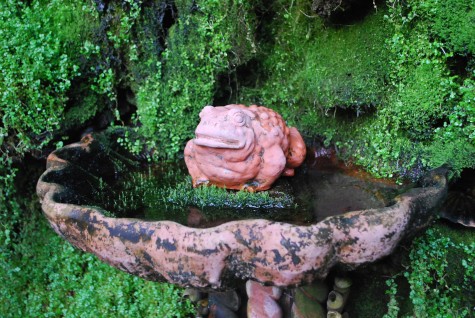 What’s new-we are on the verge of a change of seasons. Is that new? No, not really. The change of the seasons, the full moon, the length of the days, the natural changing of the guard – not new, cyclical. My crocus are poking out of the ground right now like they do every year at this time. It is their time to emerge, no matter the weather. It could be a good year, or a wash for the crocus. Right now, I am watching a blizzard bury those buds out the window; I hope they survive the insult. The forecast for tonight-a shudderingly chilly 11 degrees. However there’s plenty going on inside that is new. Though I have had this Italian terra cotta frog for 15 years, he looks new, having had a much needed soak and scrub down.
What’s new-we are on the verge of a change of seasons. Is that new? No, not really. The change of the seasons, the full moon, the length of the days, the natural changing of the guard – not new, cyclical. My crocus are poking out of the ground right now like they do every year at this time. It is their time to emerge, no matter the weather. It could be a good year, or a wash for the crocus. Right now, I am watching a blizzard bury those buds out the window; I hope they survive the insult. The forecast for tonight-a shudderingly chilly 11 degrees. However there’s plenty going on inside that is new. Though I have had this Italian terra cotta frog for 15 years, he looks new, having had a much needed soak and scrub down.
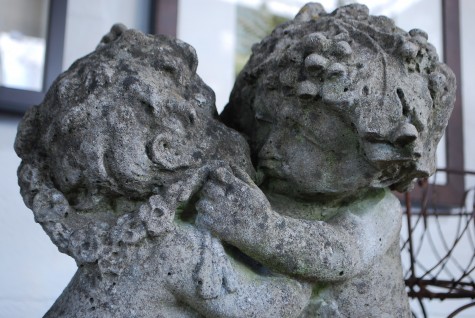 Though I can appreciate abstract sculpture in the landscape, figures and faces appeal to me more. Putti, cherubs and angels have a long history of representation in the garden. Though I have always thought cherubs and angels had a religious connotation, the putti are usually mischievious and romantic figures. This antique limestone sculpture of putti is charmingly typical. The embrace is all the more charming for a garland of flowers.
Though I can appreciate abstract sculpture in the landscape, figures and faces appeal to me more. Putti, cherubs and angels have a long history of representation in the garden. Though I have always thought cherubs and angels had a religious connotation, the putti are usually mischievious and romantic figures. This antique limestone sculpture of putti is charmingly typical. The embrace is all the more charming for a garland of flowers. 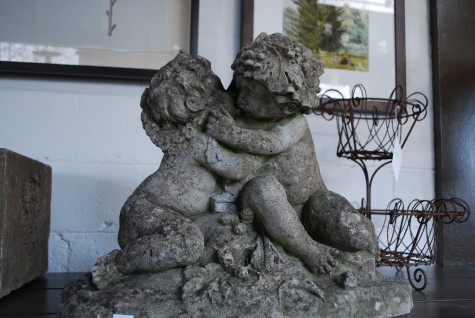 Putti were a very popular subject matter in Italian art, especially during the Renaissance and Baroque periods. Garden sculpture in the Italian style can be found in many western European countries. My collection of terra cotta pots-classical Italian in style and make. This sculpture greatly predates the cast limestone works of contemporary ornament makers, such as Haddenstone, or Chilstone, who produce their version of these kissing putti.
Putti were a very popular subject matter in Italian art, especially during the Renaissance and Baroque periods. Garden sculpture in the Italian style can be found in many western European countries. My collection of terra cotta pots-classical Italian in style and make. This sculpture greatly predates the cast limestone works of contemporary ornament makers, such as Haddenstone, or Chilstone, who produce their version of these kissing putti.
 Should kissing putti not be your idea of a great subject for a garden sculpture, we have the companion piece. These putti appear to be having a serious disagreement about something. With representational sculpture, there is a story being told-a narrative. The one is so enraged with the other, he is tugging at his own face. One cannot help but smile at the level of frustration depicted here. Both of these sculptures have been reproduced many times by different companies. The age of these sculptures imparts a patina to the surface which is as important as the subject matter.
Should kissing putti not be your idea of a great subject for a garden sculpture, we have the companion piece. These putti appear to be having a serious disagreement about something. With representational sculpture, there is a story being told-a narrative. The one is so enraged with the other, he is tugging at his own face. One cannot help but smile at the level of frustration depicted here. Both of these sculptures have been reproduced many times by different companies. The age of these sculptures imparts a patina to the surface which is as important as the subject matter.
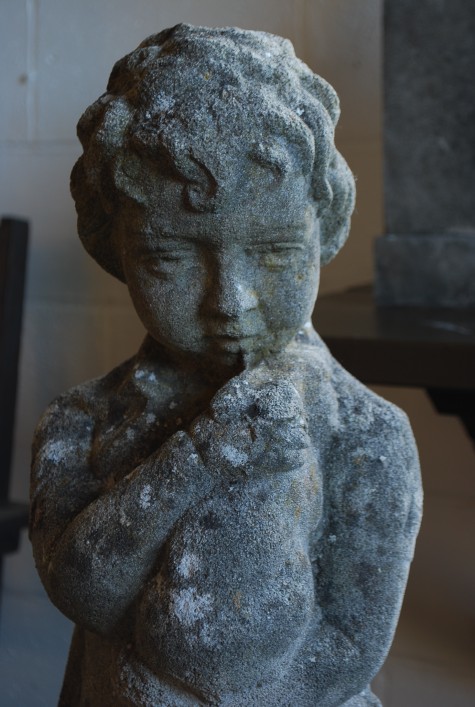 The face on this antique English garden sculpture is quietly and typically English in character. The young boy is holding a rabbit. Not seen in this picture-he is wearing nothing but a cape! I am sure there is a story here; the English garden antiques dealer from whom he came called him “Rabbit Boy”; no other information was forthcoming. His expression is serene; he will be easy to place in a special spot in a garden.
The face on this antique English garden sculpture is quietly and typically English in character. The young boy is holding a rabbit. Not seen in this picture-he is wearing nothing but a cape! I am sure there is a story here; the English garden antiques dealer from whom he came called him “Rabbit Boy”; no other information was forthcoming. His expression is serene; he will be easy to place in a special spot in a garden.
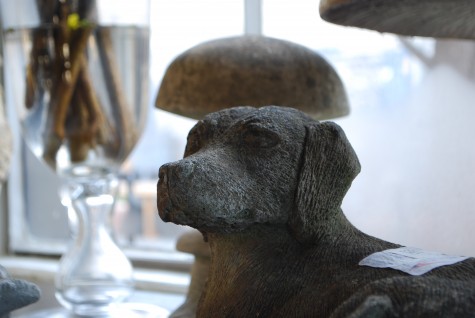 This carved concrete dog is old enough to have acquired a great patina. The dog has that stoic serious look that I love so much about my corgi Howard. There are those dogs that have jobs, and take their job to heart like this retriever-and then there are clown dogs like my Milo.
This carved concrete dog is old enough to have acquired a great patina. The dog has that stoic serious look that I love so much about my corgi Howard. There are those dogs that have jobs, and take their job to heart like this retriever-and then there are clown dogs like my Milo.
 More than likely, this is an antique architectural casting that might have been a medallion on a wall or pillar. I am guessing here. The origin of this cherubic face-I have no idea. Lots of garden and architectural ornament was produced with no stamp or identifying marks. We can often date an iron piece based on the level of corrosion, the composition or appearance of the paint, or lichens growing on the surface. Some blackened limestone pieces can be dated to the Industrial Revolution. But often the story needs to come from the imagination.
More than likely, this is an antique architectural casting that might have been a medallion on a wall or pillar. I am guessing here. The origin of this cherubic face-I have no idea. Lots of garden and architectural ornament was produced with no stamp or identifying marks. We can often date an iron piece based on the level of corrosion, the composition or appearance of the paint, or lichens growing on the surface. Some blackened limestone pieces can be dated to the Industrial Revolution. But often the story needs to come from the imagination.
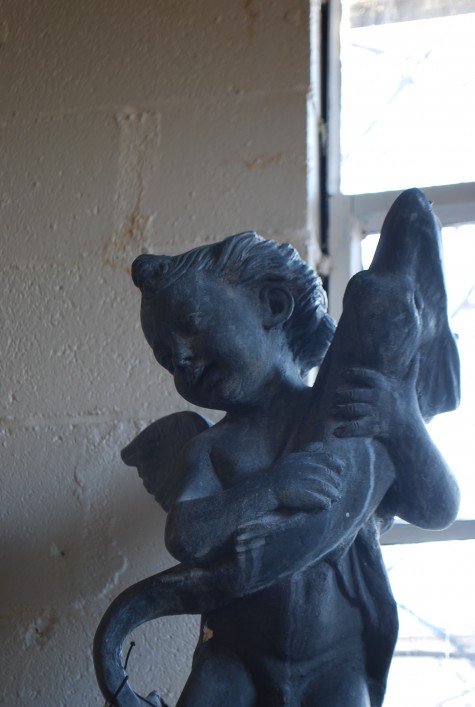 This vertical spouting lead fountain of a boy holding a fish is easier to trace. Made by H. Crowther Ltd. in London, it is after the original by Verrochio, sculpted between 1435 and 1488. The orginal is still on display at the Palazzo Vecchio in Florence, Italy. It is another example of a figurative representation so popular with gardeners it is still made to the present day.
This vertical spouting lead fountain of a boy holding a fish is easier to trace. Made by H. Crowther Ltd. in London, it is after the original by Verrochio, sculpted between 1435 and 1488. The orginal is still on display at the Palazzo Vecchio in Florence, Italy. It is another example of a figurative representation so popular with gardeners it is still made to the present day.
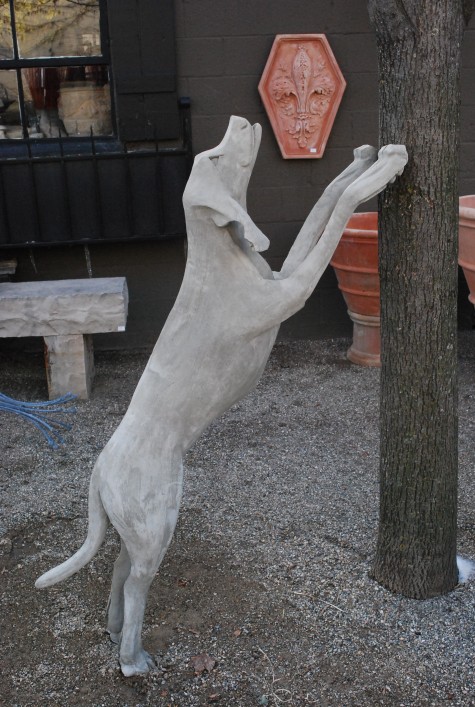 A local sculptor is in the process of hand carving his third pack of hounds for me. A steel and concrete core is finished with a hand carved mortar layer. This hound barking up a tree is a perfect garden ornament, as it clearly interacts with the landscape. The sculpture is very contemporary and pared down interpretation of the spirit of a hound.
A local sculptor is in the process of hand carving his third pack of hounds for me. A steel and concrete core is finished with a hand carved mortar layer. This hound barking up a tree is a perfect garden ornament, as it clearly interacts with the landscape. The sculpture is very contemporary and pared down interpretation of the spirit of a hound.

A bust is a sculpture representing the head, shoulders and upper chest of a person. This particular carved stone bust is English. Who is portrayed here, I have no idea. A bust can be a powerful focal point in a garden, especially if set at eye level. Making eye contact is one of those complicated things that living creatures do. Any of these sculptures new to the shop, I would place in the garden at eye level, so the conversation could begin.
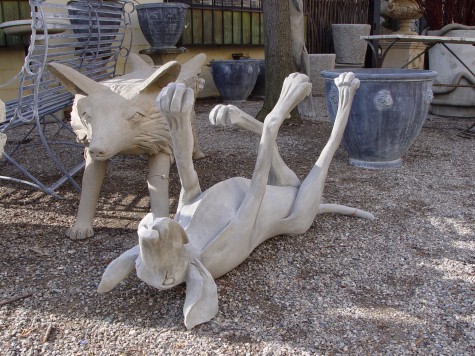 I am very pleased that Troy is in the process of creating his third collection of hand sculpted concrete hounds for the Branch Studio, as all but one of the original 18 dogs have been sold. Detroit Garden Works gets inquiries about them regularly-no wonder. His sculptures accurately represent the forms of the hounds, but what is extraordinary about them is how they capture the soul and being of of a hound. He grew up in a rural Michigan community in a family that hunted, gardened, fished, and grew a lot of their own food. He was a naturalist, farmer, fruit grower, plantsman and gardener before he ever turned to sculpture. His understanding of the natural world is evident in all of his work.
I am very pleased that Troy is in the process of creating his third collection of hand sculpted concrete hounds for the Branch Studio, as all but one of the original 18 dogs have been sold. Detroit Garden Works gets inquiries about them regularly-no wonder. His sculptures accurately represent the forms of the hounds, but what is extraordinary about them is how they capture the soul and being of of a hound. He grew up in a rural Michigan community in a family that hunted, gardened, fished, and grew a lot of their own food. He was a naturalist, farmer, fruit grower, plantsman and gardener before he ever turned to sculpture. His understanding of the natural world is evident in all of his work.
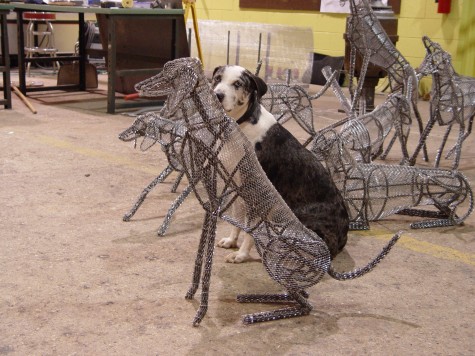 His Annie is a Cattahoula Leopard cur-one of the oldest North American mongrel breeds. Bred in Loiusiana to hunt wild boar, they are also known as Catahoula hog dogs. Fiercely dog-like, smart, energetic and unruly, Annie is much more like a wolf than a poodle. That barely civilized soul of hers you can see loud and clear in Troy’s sculptures.
His Annie is a Cattahoula Leopard cur-one of the oldest North American mongrel breeds. Bred in Loiusiana to hunt wild boar, they are also known as Catahoula hog dogs. Fiercely dog-like, smart, energetic and unruly, Annie is much more like a wolf than a poodle. That barely civilized soul of hers you can see loud and clear in Troy’s sculptures.
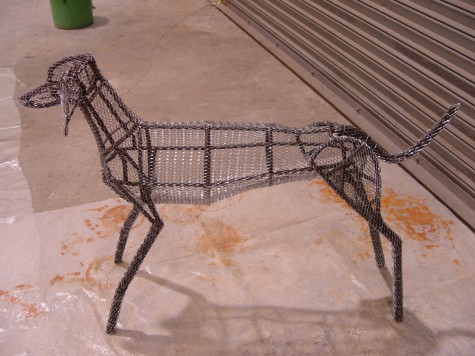 The sculptures begin with the a steel rebar armature that gets covered with a heavy duty wire mesh. The armature is designed and built to give the concrete strength, not describe the finished shape. But even at this stage, it is easy to see that the finished sculpture will have energy and grace.
The sculptures begin with the a steel rebar armature that gets covered with a heavy duty wire mesh. The armature is designed and built to give the concrete strength, not describe the finished shape. But even at this stage, it is easy to see that the finished sculpture will have energy and grace.
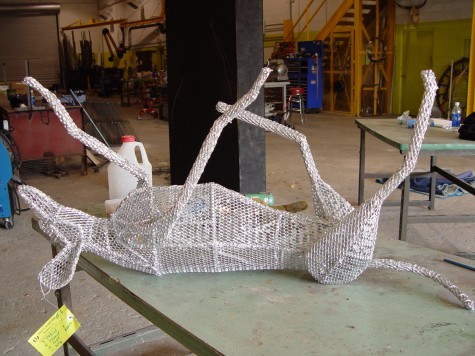 The frame is hot dip galvanized, to keep the steel from rusting once it is coated with cement. Steel and cement in contact with one another is an unfriendly affair. Cement absorbs water; steel in contact with water rusts. The galvanizing process helps keep the two materials away from each other.
The frame is hot dip galvanized, to keep the steel from rusting once it is coated with cement. Steel and cement in contact with one another is an unfriendly affair. Cement absorbs water; steel in contact with water rusts. The galvanizing process helps keep the two materials away from each other.
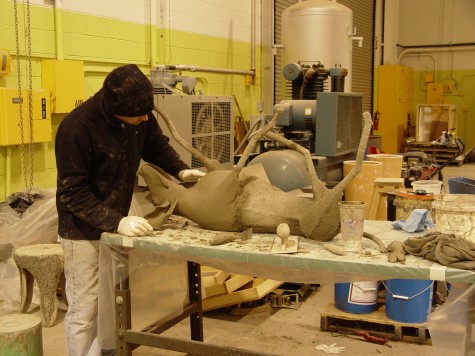 The entire form is packed solid with cement; this is a time consuming and tedious affair. Once the form has cured, a layer of mortar is applied, and hand carved. This is a simple description of a process which requires a considerable knowledge of how mortar can be worked before it sets up. I have watched him work an entire day when all the mortar would do is fall off the concrete. Or another day when nothing was to his liking; he would chip it all off the next day.
The entire form is packed solid with cement; this is a time consuming and tedious affair. Once the form has cured, a layer of mortar is applied, and hand carved. This is a simple description of a process which requires a considerable knowledge of how mortar can be worked before it sets up. I have watched him work an entire day when all the mortar would do is fall off the concrete. Or another day when nothing was to his liking; he would chip it all off the next day.
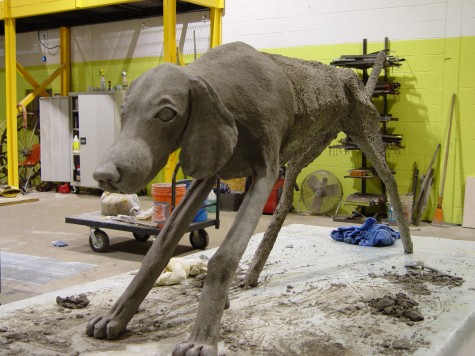 Should the mortar set up faster than you can sculpt it-troublesome. A clear understanding of how the materials work allows him to concentrate on what makes these dogs sculpture. To the last they have energy, attitude, rhythm, tension-life.
Should the mortar set up faster than you can sculpt it-troublesome. A clear understanding of how the materials work allows him to concentrate on what makes these dogs sculpture. To the last they have energy, attitude, rhythm, tension-life.
 Each dog would have a whole lot of one thing going on. His sleeping dogs would be sleeping deeply, oblivious to all else. His howling dogs would keep on howling, or howl louder. His playing dogs had nothing else on their mind except play.They were all engaged in some singular hound activity. Whether sleeping, playing or barking at the moon, I knew they would really come to life outdoors.
Each dog would have a whole lot of one thing going on. His sleeping dogs would be sleeping deeply, oblivious to all else. His howling dogs would keep on howling, or howl louder. His playing dogs had nothing else on their mind except play.They were all engaged in some singular hound activity. Whether sleeping, playing or barking at the moon, I knew they would really come to life outdoors.
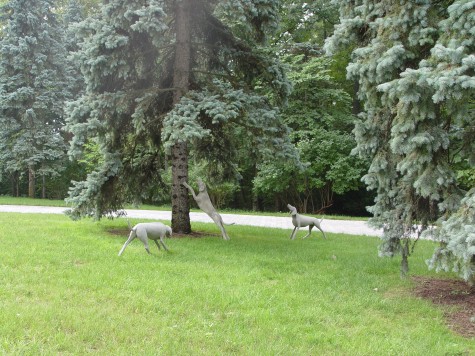 Though I really like all kinds of sculpture in a garden, I am particularly fond of these. They are of a scale and grace that makes them as natural as they are striking. Imagine this moment in the landscape without the hounds-sleepy. Garden sculpture that does not necessarily engage, energize or require a landscape does not appeal to me as much. The dogs look great from a distance, as they are very simple and direct expression of the artist’s view of the living world. Don’t ask me what I mean by this, but these dogs are as witty as they are wily.
Though I really like all kinds of sculpture in a garden, I am particularly fond of these. They are of a scale and grace that makes them as natural as they are striking. Imagine this moment in the landscape without the hounds-sleepy. Garden sculpture that does not necessarily engage, energize or require a landscape does not appeal to me as much. The dogs look great from a distance, as they are very simple and direct expression of the artist’s view of the living world. Don’t ask me what I mean by this, but these dogs are as witty as they are wily.  I doubt my garden will ever have a 19th century limestone sculpture of the huntress Diana, a steel sculpture done by Richard Sera, or a Deborah Butterfield horse, but it could have this dog. I could move it to a different spot every year. I am guessing that before long the dog would have a name.
I doubt my garden will ever have a 19th century limestone sculpture of the huntress Diana, a steel sculpture done by Richard Sera, or a Deborah Butterfield horse, but it could have this dog. I could move it to a different spot every year. I am guessing that before long the dog would have a name.
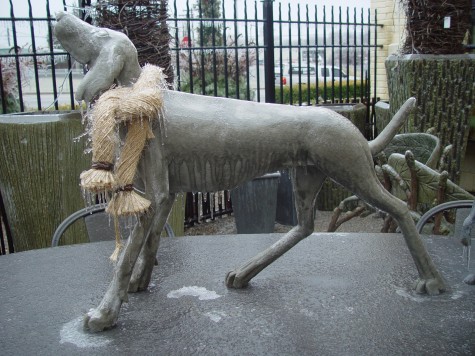
When Annie would visit, no surface outdoors was too high off the ground for her, or off limits to her. You could not help but admire all that energy and zest for the out of doors. See what I mean?
 Any person who has ever had a mind to cultivate a garden has a love for all of nature’s creatures. Even the aphids I squish, and the Japanese beetles I whisk into bags for the trash, the rabbits, the white flies on my dahlias that enrage me, the bloody slugs-I still have a tough time not welcoming any of nature’s creatures to my garden. I might as well put up a sign: Any natural transient welcome: room and board available at no charge and please, stay as long as you like. No wonder that sculptures of bugs, birds, dogs, are every bit as interesting to gardeners as sculptures of the human sort.
Any person who has ever had a mind to cultivate a garden has a love for all of nature’s creatures. Even the aphids I squish, and the Japanese beetles I whisk into bags for the trash, the rabbits, the white flies on my dahlias that enrage me, the bloody slugs-I still have a tough time not welcoming any of nature’s creatures to my garden. I might as well put up a sign: Any natural transient welcome: room and board available at no charge and please, stay as long as you like. No wonder that sculptures of bugs, birds, dogs, are every bit as interesting to gardeners as sculptures of the human sort.
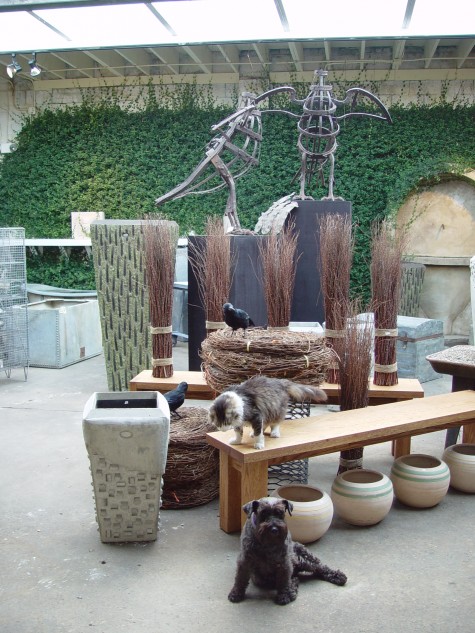 Gardeners understand that people don’t own the planet, they are but one species among a whole planet of species. My shop has always been friendly to all manner of fauna. The corgis have been here every day for the last four years, and MCat maybe 7 years; these three came during the reign of Hoppy the toad, Jojo the cat and Jack and Libby, the mini schnauzers. Who knows who or how another creature might be added to the current Corgi administration; anything can change. The place would not seem right without them; many people know them by name, bring treats, or pitch the ball down the driveway for them. These astonishing cast and wrought iron armatures are all that remain of a pair of eagle sculptures from France, some several hundred years old. Though made of iron, they have an unmistakeable air of power and vitality. The little faux crows-we like these too.
Gardeners understand that people don’t own the planet, they are but one species among a whole planet of species. My shop has always been friendly to all manner of fauna. The corgis have been here every day for the last four years, and MCat maybe 7 years; these three came during the reign of Hoppy the toad, Jojo the cat and Jack and Libby, the mini schnauzers. Who knows who or how another creature might be added to the current Corgi administration; anything can change. The place would not seem right without them; many people know them by name, bring treats, or pitch the ball down the driveway for them. These astonishing cast and wrought iron armatures are all that remain of a pair of eagle sculptures from France, some several hundred years old. Though made of iron, they have an unmistakeable air of power and vitality. The little faux crows-we like these too.
 Troy’s sculptures of birds and animals speak much to his respect and love of nature. His work has great appeal, for good reason. I so love how directly he sculpts. Some garden sculpture is more about the technique of the sculptor, rather than the feeling of the sculpture itself. People readily sort this out, and gravitate towards that which strikes a chord for them. Whether it be for fun, or in memory of something or someone, an appreciation for art in a garden comes naturally.
Troy’s sculptures of birds and animals speak much to his respect and love of nature. His work has great appeal, for good reason. I so love how directly he sculpts. Some garden sculpture is more about the technique of the sculptor, rather than the feeling of the sculpture itself. People readily sort this out, and gravitate towards that which strikes a chord for them. Whether it be for fun, or in memory of something or someone, an appreciation for art in a garden comes naturally.
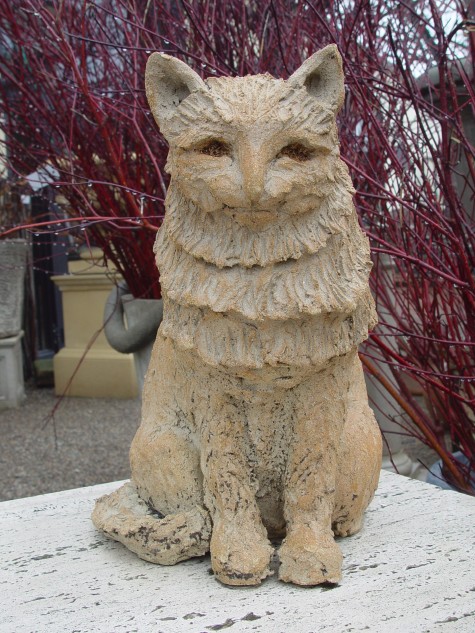 Mary Hode is an English sculptor of formidable talent. Her husband fashions garden pots I treasure. But her stoneware sculptures of cats are so beautiful, I would be confident asking any person to consider adding her work to their collection-whether for inside or out. Their faces have a distinctly human look about them; I understand this. I do believe my Corgis are people in dog costumes.
Mary Hode is an English sculptor of formidable talent. Her husband fashions garden pots I treasure. But her stoneware sculptures of cats are so beautiful, I would be confident asking any person to consider adding her work to their collection-whether for inside or out. Their faces have a distinctly human look about them; I understand this. I do believe my Corgis are people in dog costumes.
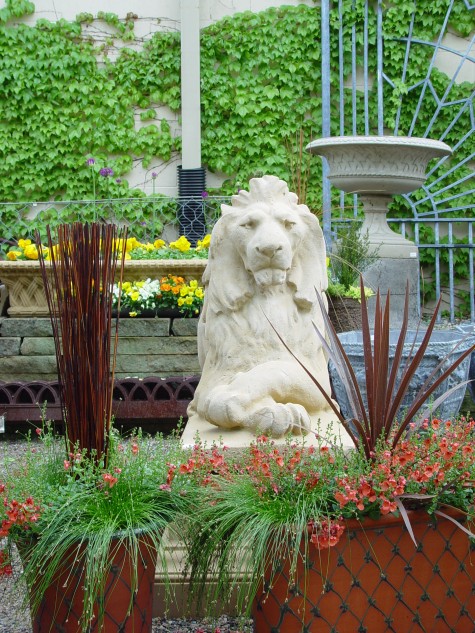 No lion lives in my zone, but the lion is a very popular motif in garden sculpture. They are on duty every day, holding court, standing watch. This English cast stone lion has a very British culture feeling to it.
No lion lives in my zone, but the lion is a very popular motif in garden sculpture. They are on duty every day, holding court, standing watch. This English cast stone lion has a very British culture feeling to it.
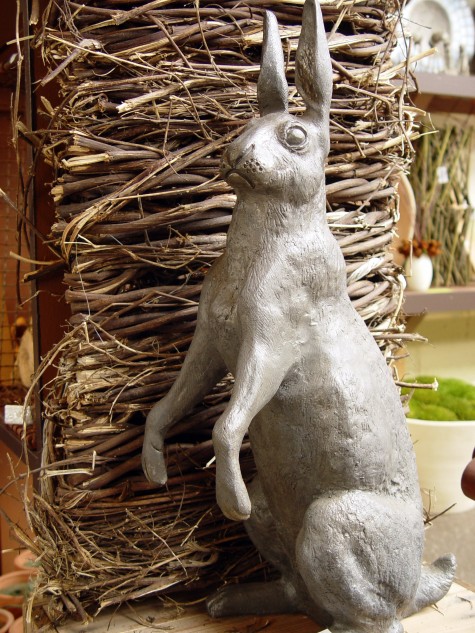 This finely detailed lead hare comes from the English lead ornament company known as Crowther and Sons. What gardener in my zone has not shared their garden with the rabbits? I do love the expression-you think he ate the lilies??
This finely detailed lead hare comes from the English lead ornament company known as Crowther and Sons. What gardener in my zone has not shared their garden with the rabbits? I do love the expression-you think he ate the lilies??
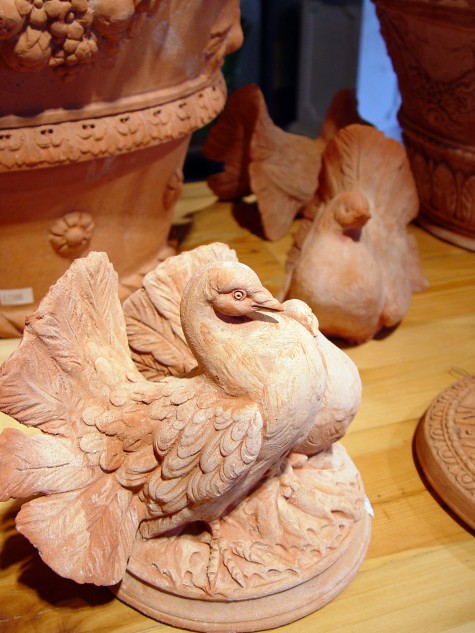 This handmade Italian terra cotta sculpture of a dove is beautifully rendered. I like small terra cotta sculptures like this, keeping my pots company over the summer. I have spots for them indoors, for the winter.
This handmade Italian terra cotta sculpture of a dove is beautifully rendered. I like small terra cotta sculptures like this, keeping my pots company over the summer. I have spots for them indoors, for the winter.
 This Belgian concrete terrier circa 1930 has a sassy terrier expression, indeed. I gave him a rope collar for the winter. I never had much interest in the doll thing, but I do like dressing my sculpture for an occasion. Just for fun.
This Belgian concrete terrier circa 1930 has a sassy terrier expression, indeed. I gave him a rope collar for the winter. I never had much interest in the doll thing, but I do like dressing my sculpture for an occasion. Just for fun.

This concrete poodle got a very stylish holiday wreath hat made from red wood shavings. This dignified little dog, suffering the indignity of this silly hat, got plenty of attention until one gardener found him impossible to resist, and took him home. I like this part of gardening-most everything about it is irresistible.
Deborah Silver is a landscape and garden designer whose firm, Deborah Silver and Co Inc, opened its doors in 1986. She opened Detroit Garden Works, a retail store devoted to fine and unusual garden ornament and specialty plants, in 1996. In 2004, she opened the Branch studio, a subsidiary of the landscape company which designs and manufactures garden ornament in a variety of media. Though her formal education is in English literature and biology, she worked as a fine artist in watercolor and pastel from 1972-1983. A job in a nursery, to help support herself as an artist in the early 80’s evolved into a career in landscape and garden design. Her landscape design and installation projects combine a thorough knowledge of horticulture with an artist’s eye for design. Her three companies provide a wide range of products and services to the serious gardener. She has been writing this journal style blog since April of 2009.
Copyright © 2024 · Deborah Silver & Co. · Detroit Garden Works